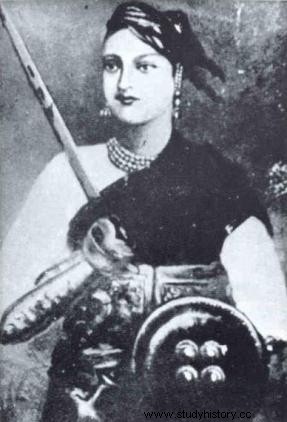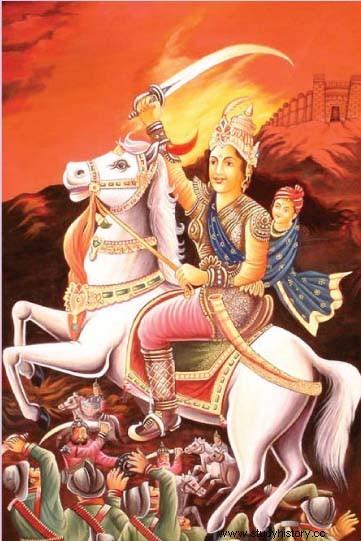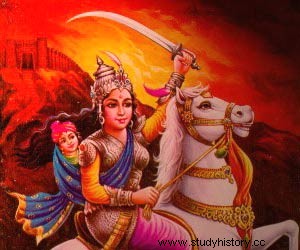The story of Rani Lakshmi Bai She could well have been the princess from a fairy tale with her Prince Charming, but the ups and downs of life and the British colonization of India turned her into a warrior.
Manikarnika or Manu , which was her real name, she lost her mother when she was four years old and her father had to take care of her education. The closeness to power, her father worked with the Peshwa (Prime Minister), allowed her to have access to other disciplines such as horse riding - they say that she even handled the horse with the reins in her mouth -, wrestling, archery... in addition to those of a woman. At age 12 she married Maharaja Jhansi , Raja Rao Gangadhar Niwalkar , and she changed her name to Rani (queen ) Lakshmi Bai . Everything was rosy until the joy of having a child turned into sorrow when she passed away at 4 months. A short time later the Maharaja fell ill and, given the impossibility of having more children, they decided to adopt Rao Damodar , son of a recently deceased cousin of the Maharaja. In addition to relieving the pain, they ensured that the British East India Company Jhansi could not be annexed by applying the Expiry Doctrine . According to this doctrine, if the ruler of any state or territory was “manifestly incompetent or died without a direct heir ” Automatically said territory passed into the hands of the Company. At the age of 18, she became a widow and began to practice as a Rani.

The British did not accept Rao Damodar as the legal heir and, applying the Expiration Doctrine, the Company annexed Jhansi. But Lakshmi Bai was not going to sit idly by. She tried the legal route and hired a British lawyer and filed an appeal against that outrage... her request for her was denied . As the legal route did not work, she recruited an army of 14,000 volunteers – for the first time made up of men and women – and faced the British. For several weeks they withstood the attack but the military power of the British subdued the rebels. According to the legend of this Hindu heroine, when she was cornered she tied her son to her back and, brandishing a sword in each hand, she was able to escape, along with a group of rebels, to the fortress of kalpi .

Parallel to the Lakshmi Bai struggle in India, the so-called Sepoy Rebellion had broken out. In 1857, the Company, with a powerful army of 40,000 British and 200,000 sepoys (local Hindu and Muslim soldiers), began using the Lee-Enfield rifle. in which to introduce the cartridges they had to be broken at one end and what was usually done was to bite them. Rumors began to spread that the cartridges were greased with pork and beef fat. As for the Muslims the pig is an impure animal and for the Hindus the cow is a sacred animal, they refused to use the new rifles and the British officers locked them up. The next day, the 10th and 20th Bengal Cavalry Regiments at Meerut, they revolted against their officers. They freed the prisoners and attacked the European enclaves in the area, killing all Europeans.
In Kalpi, Lakshmi Bai joined Tatya Tope one of the rebel leaders and clashed in Gwalior British General Sir Hugh Rose who had pursued her from Jhansi. In the course of the battle, Lakshmi Bai was shot in the back and killed. Sir Hugh Rose's words make clear the queen's bravery:
Of the mutineers the bravest and the greatest was the Rani.
In 1858, at the age of 22, Lakshmi Bai became an icon of the rebellion and in almost all representations (sculptures, paintings, engravings...) she appears on a horse and with her son on her back.

